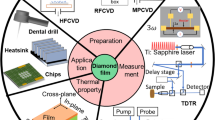Abstract
The structure, properties and tribological behavior of DLC films are dependent on the deposition process, the hydrogen concentration and chemical bondings in the films. The present paper reports selected tribological experiments on model DLC films with different hydrogen contents. The experiments were performed in ultrahigh vacuum or in an atmosphere of pure hydrogen or argon in order to elucidate various friction mechanisms. Two typical friction regimes are identified. High steady-state friction in UHV (friction coefficient of 0.6) is observed for the lowest hydrogenated and mostly sp2-bonded DLC film. Superlow steady-state friction (friction coefficient in the millirange) is observed both for the highest hydrogenated film in UHV, and for the lowest hydrogenated film in an atmosphere of hydrogen (10 hPa). The high steady-state friction in UHV, observed for the lowest hydrogenated film with a dominant sp2 carbon hybridization, is associated with a π–π* sub-band overlap responsible for an increased across-the-plane chemical bonding with a high shear strength similar to what is observed with unintercalated graphite in the same UHV conditions. Superlow friction is correlated with a hydrogen saturation across the shearing plane through weak van der Waals interactions between the polymer-like hydrocarbon top layers. This regime is observed during the steady-state period if the film contains enough hydrogen incorporated during deposition. If this condition is not satisfied (i.e., for the film with the lowest hydrogen content), the limited diffusion of hydrogen from the film network towards the sliding surfaces seems to be responsible for a superlow running-in period. The superlow friction level can be reached over longer time periods by suitable combinations of temperature and molecular hydrogen present in the surrounding atmosphere during friction.
Similar content being viewed by others
References
A. Grill, Diamond Relat. Mater. 8 (1999) 428.
A. Erdemir and C. Donnet, in: Handbook of Modern Tribology, ed. B. Bhushan (CRC Press, Boca Raton), in press.
J. Robertson, in: Amorphous Carbon: State of the Art, eds. S.R.P. Silva, J. Robertson, W. Milne and G.A. Amaratunga (World Scientific, Singapore, 1998) p. 32.
A. Grill and B. Meyerson, in: Synthetic Diamond: Emerging CVD Science and Technology, eds. K.E. Spear and J. Dismukes (Wiley, New York, 1994) p. 91.
C. Donnet, F. Lefebvre, A. Grill, J. Fontaine, V. Patel and C. Jahnes, J. Appl. Phys. 85 (1999) 3264.
A. Grill and V. Patel, Appl. Phys. Lett. 60 (1992) 2089.
C. Donnet, Surf. Coat. Technol. 100-101 (1998) 180.
M.N. Gardos, in: New Directions in Tribology, Proc. 1st World Tribology Congr., London, 8-12 September 1997 (Mechanical Engineering Publications, London, 1997) p. 229.
C. Donnet and A. Grill, Surf. Coat. Technol. 94–95 (1997) 456.
M.N. Gardos and S.A. Gabelich, Tribol. Lett. 6 (1999) 103.
J.N. Israelachivili, in: Fundamentals of Friction: Macroscopic and Microscopic Processes, NATO-ASI Series, Vol. 220, eds. I.L. Singer and H.M. Pollock (Kluwer Academic, Dordrecht, 1992) p. 351.
J.M. Georges, in: New Directions in Tribology, Proc. 1st World Tribol. Congr., London, 8-12 September 1997 (Mechanical Engineering Publications, London, 1997) p. 67.
I. Sugimoto and S. Miyake, Appl. Phys. Lett. 56 (1990) 1868.
M.N. Gardos, in: Synthetic Diamond: Emerging CVD Science and Technology, eds. K.E. Spear and J. Dismukes (Wiley, New York, 1994) p. 419.
M.S. Dresselhouse and G. Dresselhouse, Adv. Phys. 30 (1981) 139.
Author information
Authors and Affiliations
Rights and permissions
About this article
Cite this article
Donnet, C., Fontaine, J., Grill, A. et al. The role of hydrogen on the friction mechanism of diamond-like carbon films. Tribology Letters 9, 137–142 (2001). https://doi.org/10.1023/A:1018800719806
Issue Date:
DOI: https://doi.org/10.1023/A:1018800719806




